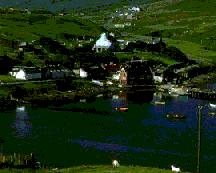- Description
- Picts and the Pictish language
- Ogham Alphabet
- Indo-European Chronology (Celtic)
- Celtic Links
 By
the 15th century, with the accretion of Norse and English loan words, the
Scottish branch differed significantly enough from the Irish to warrent
definition as a separate language. And nowadays these two tongues
though having very much in common in vocabulary and grammar, are different.
By
the 15th century, with the accretion of Norse and English loan words, the
Scottish branch differed significantly enough from the Irish to warrent
definition as a separate language. And nowadays these two tongues
though having very much in common in vocabulary and grammar, are different.
The alphabets of Irish and Scottish Gaelic are indentical, consisting
of 18 letters. Scottish employs four cases of nouns: nominative,
genitive, dative and vocative (Irish uses three). Like Irish, the
accent is usually on the initial syllable.
Scottish Gaelic exists in two main dialects, Northern and Southern,
geographically determined by a line roughly up the Firth of Lorne to the
town of Ballachulish and then across to the Grampian Mountains, which it
follows northeasterly. The Southern dialect is more akin to Irish
than is the Northern, and is more inflected. The main difference
is the change of the Indo-European sound, which
is eu in the Northern dialect and ia in the
Southern. Thus the word for "grass" is pronounced feur
in Northern and fiar in Southern. But most linguists
can find many more varieties of the language, each having its own peculiarities.
In fact, Scottish Gaelic is endangered today by the permanent expansion
of English and Scots both. Only on the islands to the west can people
be found who speak only Gaelic. On the mainland everyone understands
English and slowly their native tongue is lost to them.